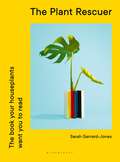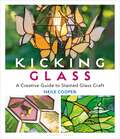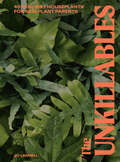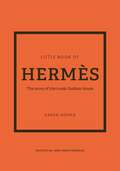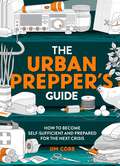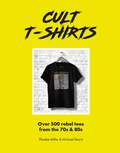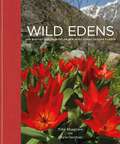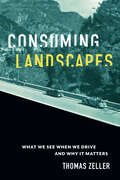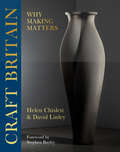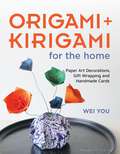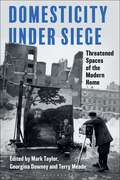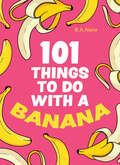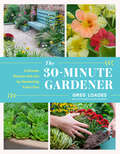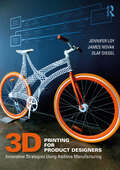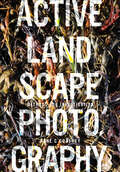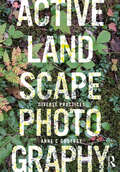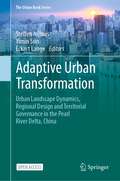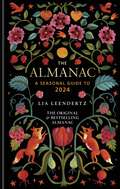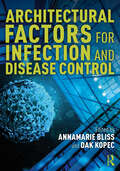- Table View
- List View
The Plant Rescuer: The book your houseplants want you to read
by Sarah Gerrard-JonesA simple, stylish and complete guide for any houseplant ownerWhether you have just one or many houseplants, this is the book they need you to read. It is a clear and practical toolkit on all aspects of plant care from how to choose a plant to tips for everyday care. Changes in your plant's appearance are often a cry for help and this book will help you understand their needs. Learn how to help your plants not only survive but thrive. Sarah, also known as @theplantrescuer, is a self-taught houseplant obsessive who firmly believes every plant deserves a happy life. Her determination to see beyond the 'perfect plant' and to rescue unloved plants makes her the go-to guide.
Kicking Glass: A Creative Guide to Stained Glass Craft
by Neile CooperCreative and practical, Kicking Glass is a step-by-step guide for those wanting to practice the popular craft of stained glass. From simple suncatchers and boho lamps to exquisite 3D constructions and delicately-poised glass butterflies, experienced artist Neile Cooper guides you through the magical world of stained glass with a creative handbook for both the novice and more experienced crafter alike. Beautifully illustrated with photographs of Neile's own work including her glorious glass cabin in the woods as well as pieces from some of today's most stylish designers, Kicking Glass is packed with ideas to guide and inspire. This book provides comprehensive technical instruction in the copper foil method, covering everything from tools and supplies to exploratory techniques such as including foraged and found objects into your work. Skills are demonstrated through tutorials with photos, instructional drawings and 16 stunning patterns. Whether you're looking to decorate your windows, create lovely gifts for friends and family or design your own epic masterpiece, Kicking Glass is the essential modern guide to stained glass making.
The Unkillables: 40 resilient house plants for new plant parents
by Jo LambellFeaturing over 40 cool, high-maintenance-looking plants, The Unkillables will ensure your put your plant-murdering days firmly in the past, and will transform your home into the gorgeous green space you always dreamed of. Are you a plant killer? There's nothing more heart-breaking than bringing your new plant baby home, only to have it die a slow death in front of your very eyes. Was it too much water? Not enough sunlight? A drafty corner? The reasons for planticide can seem endless!In The Unkillables, Jo Lambell shares her houseplant knowledge so that even the biggest plant serial killers can have an abundant indoor garden. Jo will take the fear out of the unknown and equip those with no green fingers at all with the skills they need to keep their plants alive and thriving. Plants can be a little intimidating – with their fancy Latin names, complex terminology and 'just look at me and I'll perish' reputation – so choosing hardy, tolerant plants is the best place to start. Jo walks you through the basics of care – light, water, location – as well as sharing information on repotting, propagating, cleaning, First Aid and more.
The Little Book of Hermès: The story of the iconic fashion house (Little Book Of Fashion Ser.)
by Karen HomerThe iconic bags, the instantly recognizable packaging, the celebrity fans – Hèrmes is the last word in luxurious accessories. Through the generations, Hermès have created innovative and exquisite accessories for the most glamorous customers. From their nineteenth-century saddlery workshop to 1960s Paris and beyond, Hermès has graced the arms and wardrobes of style icons from Grace Kelly and Jane Birkin to Victoria Beckham and Kim Kardashian. Little Book of Hermès tells the story of the evolution of the House of Hermès, through beautiful illustrations of the most coveted items and authoritative text by fashion historian Karen Homer.
The Urban Prepper's Guide: How To Become Self-Sufficient And Prepared For The Next Crisis
by Jim CobbPrepare for future worst-case scenarios while learning to be self-sufficient every day. It's become clear that even in the twenty-first century our comfortable lives can be disrupted at a moment's notice by events far beyond our control. Whether these are global disasters like a pandemic or a continent-spanning war, or local catastrophes like wildfires, floods, power outages or even food-and-essentials supply issues, you need to know how to respond to a wide variety of emergencies.Written by Jim Cobb, an authority on prepping and disaster readiness, The Urban Prepper's Guide will introduce you to techniques and strategies that can prepare your home and loved ones. These simple measures – designed specifically for urban and suburban dwellers who have tight budgets and limited space – include: • Water – how to safely store and purify water • Food – how to store, preserve, and cook food in an emergency • Shelter – how to shield yourself from the elements without power • Medical – how to be prepared for injuries and illnesses • Security – how to protect your house and valuables • Communication – how to stay informed in an emergency • Every Day Carry – how to be ready to handle problems wherever you are • Home Safety – how to protect against fire and other accidents • Financial Preparedness – how to start planning on a tight budget • Soft Skills – how to think clearly and communicate effectively in a crisis • Emergency Evacuation – how to be ready to evacuate at a moment's notice • Mindset – how to develop a survivor's mindset, and all that entails • The First 24 Hours – how to handle everything when the worst happens
Cult T-Shirts: Over 500 rebel tees from the 70s and 80s
by Michael Reach Phoebe MillerSeminal and subversive. Iconic and experimental. Radical and underground. This collection of over 500 vintage T-shirts has them all. Symbols of rebellion – worn by skaters, punks, metalheads and surfers alike – T-shirts have dominated pop culture for decades. Featuring stunning photographs of each tee, interviews from die-hard collectors and rare treasures from celebrated designers, Cult T-Shirts is a nostalgic dive into the world of 70s and 80s rebel subcultures.
Kew - The Magic of Mushrooms: Fungi in folklore, superstition and traditional medicine
by Sandra LawrenceExplore the wonderful world of some of the most incredible natural forms on our planet – fungi.At the centre of countless superstitions, folkloric tales and magical beliefs, as well as appearing in recipes and medicines both traditional and modern, mushrooms have incredible powers.Featuring images of over 100 fascinating species, sourced from the archives at the Royal Botanic Gardens, Kew, The Magic of Mushrooms shows that from saving lives to expanding the mind, the potential of these fascinating organisms should not be underestimated.
Sneakers: Over 300 classics from rare vintage to the latest kicks
by Neal HeardADIDAS SUPERSTAR. NIKE AIR MAX. ONITSUKA TIGER CORSAIR. BALENCIAGA TRIPLE S. YEEZY 700. STAN SMITH. VANS OLD SKOOL. AIR JORDAN.With over 300 styles and including all the essential trends and brands, this is the ultimate sneaker handbook.
Wild Edens
by Chris Gardner Toby MusgraveExplore the world through a horticultural lens in Wild Edens: an armchair traveller's guide to interesting plants from around the world. Discover the fascinating history and origins of a collection of unique flora, often from hard-to-reach locations in the globe's most abundant biodiversity hotspots, such as Ixia dubia in the Western Cape and the Mediterranean's Crocus biflorus.Each chapter includes a map, personal reflections from the author about exploring these often-remote locations, scene-setting descriptions on topography, geography, climate and flora, key botanical locations within the hotspot, a plant compendium and summary of how the plants impacted garden fashions/styles. Tapping into the revival in interest of nature, gardening and the natural world, this is a premium armchair traveller's guide to interesting plants, flora and fauna from around the world, often from locations that are hard to visit, even without a global pandemic.
Consuming Landscapes: What We See When We Drive and Why It Matters
by Thomas ZellerWhat we see through our windshields reflects ideas about our national identity, consumerism, and infrastructure.For better or worse, windshields have become a major frame for viewing the nonhuman world. The view from the road is one of the main ways in which we experience our environments. These vistas are the result of deliberate historical forces, and humans have shaped them as they simultaneously sought to be transformed by them. In Consuming Landscapes, Thomas Zeller explores how what we see while driving reflects how we view our societies and ourselves, the role that consumerism plays in our infrastructure, and ideas about reshaping the environment in the twentieth century.Zeller breaks new ground by comparing the driving experience and the history of landscaped roads in the United States and Germany, two major automotive countries. He focuses specifically on the Blue Ridge Parkway in the United States and the German Alpine Road as case studies. When the automobile was still young, an early twentieth-century group of designers—landscape architects, civil engineers, and planners—sought to build scenic infrastructures, or roads that would immerse drivers in the landscapes that they were traversing. As more Americans and Europeans owned cars and drove them, however, they became less interested in enchanted views; safety became more important than beauty. Clashes between designers and drivers resulted in different visions of landscapes made for automobiles. As strange as it may seem to twenty-first-century readers, many professionals in the early twentieth century envisioned cars and roads, if properly managed, as saviors of the environment. Consuming Landscapes illustrates how the meaning of infrastructures changed as a result of use and consumption. Such changes indicate a deep ambivalence toward the automobile and roads, prompting the question: can cars and roads bring us closer to nature while deeply altering it at the same time?
Craft Britain: Why Making Matters
by David Linley Helen ChislettCraft is at the very heart of British identity, from stained-glass windows in country churches to the Enid Blyton charm of thatched houses; from Harris Tweed® (famously poached by Coco Chanel) to the ceremonial livery worn by horses at Buckingham Palace. The burgeoning of digital craftsmanship is also enriching ground-breaking technologies, including microbial weaving and bespoke-made vessels for growing human tissue. Craft Britain brings together watchmakers with saddlers; bell casters with neon benders; shoemakers with silversmiths; potters with orrery-makers; stonemasons with weavers; embroiderers with basket-makers – and a myriad other craft traditions.This book aims to beat the drum for craft, waking people up to the fact that they need to support the country's rich seam of incredible craftspeople and so encourage new generations to master the skills needed to preserve and continue craft traditions. Craft Britain proves that craftsmanship in Britain is neither dying nor dead, but is a continuing and exciting exploration of process, materials and ideas spanning architecture, interiors, fashion, art and design.
The GIY Diaries: A Year of Growing and Cooking
by Michael KellyMonth by month, learn how to grow fresh, nutritious fruit and vegetables that save you money, taste delicious and help you become more self-sufficient.With down-to-earth, informative accounts from Michael Kelly’s own growing year and beautiful hand-painted illustrations by Sarah Kilcoyne, this book is packed with hard-earned wisdom and inspiration that will help you to coax delicious food from even the most unpromising soil.Whether you are a complete beginner or a more experienced grower, and regardless of the amount of space you have, Michael Kelly’s expert advice will guide you. From feeding your soil and saving seeds to taking cuttings and preserving your produce, you will learn how to get it right in our climate. Each month also features recipes so that you can feast on the results of your work.
Origami and Kirigami for the Home: Paper Art Decorations, Gift Wrapping and Handmade Cards
by Wei YouA colourful guide (with accompanying online video tutorials) to creating decorative pieces for the home, parties and events alongside ideas for presents, cards and gift wrapping.Origami is the Japanese art of paper folding and kirigami is the traditional art of paper cutting. In this beautifully illustrated book, paper artist Wei You introduces you to over 30 unique projects for your home that can be made by anyone, regardless of experience. After learning the basic folds, discover different paper types – try out pretty handmade ones such as mulberry and decorative washi, or experiment with the full rainbow of classic origami paper – and find a wealth of ideas from table decorations and tiles, to gift wrap and seasonal decorations. In no time at all you will have the skills to craft delicate roses and stylish card holders, striking wall art to decorate your home, parties and events, as well as unique eco-friendly ideas for presents and cards. Easy-to-follow instructions, photographs and diagrams guide you step by step through traditional and contemporary designs and accompanying videos for each origami project will ensure you develop your skills to create some truly impressive makes. Paper is more than just a blank page to write on – grab yourself a bundle and get started folding, cutting and creating your own paper magic!
Domesticity Under Siege: Threatened Spaces of the Modern Home
Theories of the domestic stemming from the 19th century have focused on the home as a refuge and place of repose for the family, a nurturing environment for children and a safe place for visitors. Under this conception, domestic space is positioned as nurturing and private, a refuge and place of retreat which gave rise to theories of 'home as haven'. While, arguably, some social conditions might suggest this is the case, Domesticity Under Siege exposes a different world, one in which the boundaries of nurturing domesticity collide with both outside and inside agents.Whether these agents are external military forces, psychological trauma or familial violence, they re-position meta-narratives of domesticity, not through identity politics or specialized subgroup experience, but relative to the actions of the world around an inhabited domain. That is, when home is constituted as a private realm, a place where individuals or groups can reside in 'safety and comfort', it is argued as a place in which the individual exercises control or power. However, there are many occasions when forces act upon the home and threaten aspects of safety and comfort, often through such things as ruination, violence, mortality, and infestation.Organised around four thematic sections, 'Microbes, Animals and Insects', 'Human Agents', Wars and Disasters as Agents' and 'Hauntings, Eeriness and the Uncanny', chapters provide a range of approaches to the home which challenge notions of 'haven' and reflect major causes that have played an important role in undermining the modern home. Examples and case studies explore the domestic screen, hoarding, hauntings, violence and imprisonment in the home, wartime interior art, the Hanover Merzbau and Wolfgang Staudte's 1946 film Die Mörder sind unter uns ('The Murderers are Among Us').
101 Things to Do With a Banana
by B.A. NanaA bunch of truly ap-peeling things to do with this fruit basket staple.
The 30-Minute Gardener: Cultivate Beauty and Joy by Gardening Every Day
by Greg LoadesFind happiness, connection, and accomplishment by cultivating your garden life every day of the week using this inspiration-packed guide that shows aspiring gardeners exactly what they need to know. Are you ready to discover your garden&’s unexpected gifts? All it takes is a daily practice. In The 30-Minute Gardener, Greg Loadesreveals what dedicated time spent in the garden every day can create: a moment of solitude in a busy world, a welcoming space to enjoy with family and friends, and an increased connection to nature. In this practical and inspiring guide you&’ll find advice on tasks such as pruning a rose bush and planting bulbs, inspired ideas for transforming an overgrown garden into a beautiful flower-filled haven, and hints on how best to savor your garden and enjoy your accomplishments.
3D Printing for Product Designers: Innovative Strategies Using Additive Manufacturing
by Jennifer Loy James Novak Olaf Diegel3D Printing for Product Designers closes the gap between the rhetoric of 3D printing in manufacturing and the reality for product designers. It provides practical strategies to support the adoption and integration of 3D printing into professional practice. 3D printing has evolved over the last decade into a practical proposition for manufacturing, opening up innovative opportunities for product designers. From its foundations in rapid prototyping, additive manufacturing has developed into a range of technologies suitable for end-use products. This book shows you how to evaluate and sensitively understand people, process, and products and demonstrates how solutions for working with additive manufacturing can be developed in context. It includes a practical, step-by-step plan for product designers and CEOs aimed at supporting the successful implementation of 3D printing by stakeholders at all levels of a manufacturing facility, tailored to their stage of technology integration and business readiness. It features a wide range of real-world examples of practice illustrated in full colour, across industries such as healthcare, construction, and film, aligning with the strategic approach outlined in the book. The book can be followed chronologically to guide you to transform your process for a company, to meet the unique needs of a specific client, or to be used as a starting point for the product design entrepreneur. Written by experienced industry professionals and academics, this is a fundamental reference for product designers, industrial designers, design engineers, CEOs, consultants, and makers.
3D Printing for Product Designers: Innovative Strategies Using Additive Manufacturing
by Jennifer Loy James Novak Olaf Diegel3D Printing for Product Designers closes the gap between the rhetoric of 3D printing in manufacturing and the reality for product designers. It provides practical strategies to support the adoption and integration of 3D printing into professional practice. 3D printing has evolved over the last decade into a practical proposition for manufacturing, opening up innovative opportunities for product designers. From its foundations in rapid prototyping, additive manufacturing has developed into a range of technologies suitable for end-use products. This book shows you how to evaluate and sensitively understand people, process, and products and demonstrates how solutions for working with additive manufacturing can be developed in context. It includes a practical, step-by-step plan for product designers and CEOs aimed at supporting the successful implementation of 3D printing by stakeholders at all levels of a manufacturing facility, tailored to their stage of technology integration and business readiness. It features a wide range of real-world examples of practice illustrated in full colour, across industries such as healthcare, construction, and film, aligning with the strategic approach outlined in the book. The book can be followed chronologically to guide you to transform your process for a company, to meet the unique needs of a specific client, or to be used as a starting point for the product design entrepreneur. Written by experienced industry professionals and academics, this is a fundamental reference for product designers, industrial designers, design engineers, CEOs, consultants, and makers.
Active Landscape Photography: Methods for Investigation (Active Landscape Photography)
by Anne C GodfreyHow can photography be transformed into an active process of investigation for landscape architecture and environmental design? The second book in Godfrey’s series, Active Landscape Photography, presents engaged photographic methods that turn photography into a rigorous, thoughtful endeavor for the research, planning and design of landscape places. Photography is the most ubiquitous and important form of representation in these disciplines. Yet photography is not specifically taught as a core skill within these fields. This book creates a starting point for filling this gap. Concepts and working methods from contemporary photography and critical cultural theories are contextualized into situations encountered in the daily practice of landscape architecture and environmental design. These methods can be integrated into practices in academic and professional settings or picked up and self-taught by an individual reader. Part I: Methods presents easily accessible approaches to photography creating a core set of active skills. Part II: Practices discusses working methods of specific contemporary photographers and extrapolates their practices into common extrapolates their practices into common planning and design situations. Contemporary photographers presented include Richard Misrach, Dawoud Bey, Duane Michals, Latoya Ruby Frazier, Mark Klett, Sophie Calle, Joe Deal, Robert Adams, Naima Green, Bernd and Hilla Becher, Stephen Shore, David Hockney, Amy Sherald, William Christenberry, Jeff Wall, and Sohei Nishino. Beautifully illustrated in full color with over 150 images by Godfrey, her students, and contemporary photographers, this book provides both clear guidelines for a set of diverse methods as well as a deeper discussion about the implications of making and using photography in environmental design for professionals, academics, students and researchers.
Active Landscape Photography: Methods for Investigation (Active Landscape Photography)
by Anne C GodfreyHow can photography be transformed into an active process of investigation for landscape architecture and environmental design? The second book in Godfrey’s series, Active Landscape Photography, presents engaged photographic methods that turn photography into a rigorous, thoughtful endeavor for the research, planning and design of landscape places. Photography is the most ubiquitous and important form of representation in these disciplines. Yet photography is not specifically taught as a core skill within these fields. This book creates a starting point for filling this gap. Concepts and working methods from contemporary photography and critical cultural theories are contextualized into situations encountered in the daily practice of landscape architecture and environmental design. These methods can be integrated into practices in academic and professional settings or picked up and self-taught by an individual reader. Part I: Methods presents easily accessible approaches to photography creating a core set of active skills. Part II: Practices discusses working methods of specific contemporary photographers and extrapolates their practices into common extrapolates their practices into common planning and design situations. Contemporary photographers presented include Richard Misrach, Dawoud Bey, Duane Michals, Latoya Ruby Frazier, Mark Klett, Sophie Calle, Joe Deal, Robert Adams, Naima Green, Bernd and Hilla Becher, Stephen Shore, David Hockney, Amy Sherald, William Christenberry, Jeff Wall, and Sohei Nishino. Beautifully illustrated in full color with over 150 images by Godfrey, her students, and contemporary photographers, this book provides both clear guidelines for a set of diverse methods as well as a deeper discussion about the implications of making and using photography in environmental design for professionals, academics, students and researchers.
Active Landscape Photography: Diverse Practices (Active Landscape Photography)
Diverse Practices, the third book in the Active Landscape Photography series, presents a set of unique photographic examples for site-specific investigations of landscape places. Contributed by authors across academia, practice and photography, each chapter serves as a rigorous discussion about photographic methods for the landscape and their underlying concepts. Chapters also serve as unique case studies about specific projects, places and landscape issues. Project sites include the Miller Garden, Olana, XX Miller Prize and the Philando Castile Peace Garden. Landscape places discussed include the archeological landscapes of North Peru, watery littoral zones, the remote White Pass in Alaska, Sau Paulo and New York City’s Chinatown. Photographic image-making approaches include the use of lidar, repeat photography, collage, mapping, remote image capture, portraiture, image mining of internet sources, visual impact assessment, cameraless photography, transect walking and interviewing. These diverse practices demonstrate how photography, when utilized through a set of specific critical methods, becomes a rich process for investigating the landscape. Exploring this concept in relationship to specific contemporary sties and landscape issues reveals the intricacy and subtlety that exists when photography is used actively. Practitioners, academics, students and researchers will be inspired by the underlying concepts of these examples and come away with a better understanding about how to create their own rigorous photographic practices.
Active Landscape Photography: Diverse Practices (Active Landscape Photography)
by Anne C GodfreyDiverse Practices, the third book in the Active Landscape Photography series, presents a set of unique photographic examples for site-specific investigations of landscape places. Contributed by authors across academia, practice and photography, each chapter serves as a rigorous discussion about photographic methods for the landscape and their underlying concepts. Chapters also serve as unique case studies about specific projects, places and landscape issues. Project sites include the Miller Garden, Olana, XX Miller Prize and the Philando Castile Peace Garden. Landscape places discussed include the archeological landscapes of North Peru, watery littoral zones, the remote White Pass in Alaska, Sau Paulo and New York City’s Chinatown. Photographic image-making approaches include the use of lidar, repeat photography, collage, mapping, remote image capture, portraiture, image mining of internet sources, visual impact assessment, cameraless photography, transect walking and interviewing. These diverse practices demonstrate how photography, when utilized through a set of specific critical methods, becomes a rich process for investigating the landscape. Exploring this concept in relationship to specific contemporary sties and landscape issues reveals the intricacy and subtlety that exists when photography is used actively. Practitioners, academics, students and researchers will be inspired by the underlying concepts of these examples and come away with a better understanding about how to create their own rigorous photographic practices.
Adaptive Urban Transformation: Urban Landscape Dynamics, Regional Design and Territorial Governance in the Pearl River Delta, China (The Urban Book Series)
by Steffen Nijhuis Yimin Sun Eckart LangeThis open access book provides a cross-sectoral, integrative and multi-scale design and planning approach for adaptive urban transformation of fast urbanising deltas, taking the Pearl River Delta (China) as a case study. Deltaic areas are among the most promising regions in the world. Their strategic location and superior quality of their soils are core factors supporting both human development and the rise of these regions as global economic hubs. At the same time, however, deltas are extremely vulnerable to multiple threats from both climate change and urbanisation. These include an increased flood risk combined with the resulting loss of ecological and social-cultural values. To ensure a more sustainable future for these areas, spatial strategies are needed to strengthen resilience, i.e. help the systems to cope with their vulnerabilities as well as enhance their capacity to overcome natural and artificial threats.The book provides a unique approach that integrates research in urban landscape systems, territorial governance and visualisation techniques that will help to achieve more integrated and resilient deltas. Based on an assessment of the dynamics of change regarding the transformational cycles of natural and urban landscape elements, eco-dynamic regional design strategies are explored to reveal greater opportunities for the exploitation of natural and social-cultural factors within the processes of urban development.
The Almanac: A Seasonal Guide To 2018 (Almanac)
by Lia LeendertzTHE ORIGINAL & BESTSELLING ALMANACReconnect with the seasons in Britain and Ireland with this month-by-month guide to the world around us - including tide tables, sunrises and moon phases; garden feasts, wildlife and folklore; seasonal recipes, snacks and more.The Almanac: A Seasonal Guide to 2024 gives you the tools and inspiration you need to celebrate, mark and appreciate each month of the year in your own particular way.Divided into the 12 months, a set of tables each month gives it the feel and weight of a traditional almanac, providing practical information that gives access to the outdoors and the seasons, perfect for expeditions, meteor-spotting nights and beach holidays. This year's edition focuses on the natural wonders of the garden, celebrating the beautiful flora and fauna at your doorstep. There are also features on each month's unique nature, plus a flower and a snack of the month.You will find yourself referring to The Almanac all year long, revisiting it again and again, and looking forward to the next edition as the year draws to a close.PRAISE FOR THE ALMANAC:'Lia Leendertz's classic almanac never fails to delight' - The Herald'It's a perfect Christmas present' - Allan Jenkins, The Observer'The perfect companion to the seasons' - India Knight'Indispensable' - Sir Bob Geldof'This book is your bible' - The Independent'I love this gem of a book' - Cerys Matthews
Architectural Factors for Infection and Disease Control
by AnnaMarie Bliss Dak KopecThis edited collection explores disease transmission and the ways that the designed environment has promoted or limited its spread. It discusses the many design factors that can be used for infection and disease control through lenses of history, public health, building technology, design, and education.This book calls on designers to consider the role of the built environment as the primary source of bacterial, viral, and fungal transfers through fomites, ventilation systems, and overcrowding and spatial organization. Through 19 original contributions, it provides an array of perspectives to understand how the designed environment may offer a reprieve from disease. The authors build a historical foundation of infection and disease, using examples ranging from lazarettos to leprosy centers to show how the ability to control infection and disease has long been a concern for humanity. The book goes on to discuss disease propagation, putting forth a variety of ideas to control the transmission of pathogens, including environmental design strategies, pedestrian dynamics, and open space. Its final chapters serve as a prospective way forward, focusing on COVID-19 and the built environment in a post-pandemic world.Written for students and academics of architecture, design, and urban planning, this book ignites creative action on the ways to design our built environment differently and more holistically.Please note that research on COVID-19 has exponentially grown since this volume was written in October 2020. References cited reflect the evolving nature of research studies at that time.
